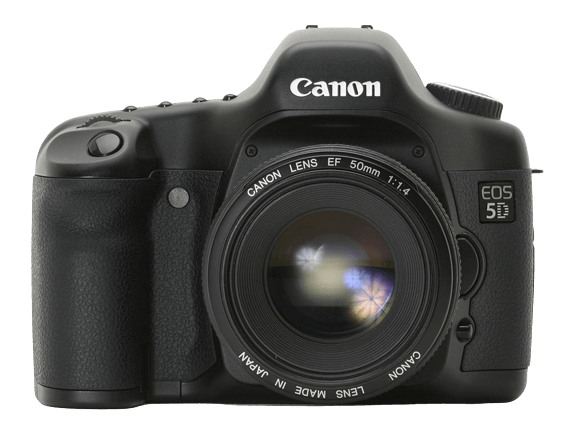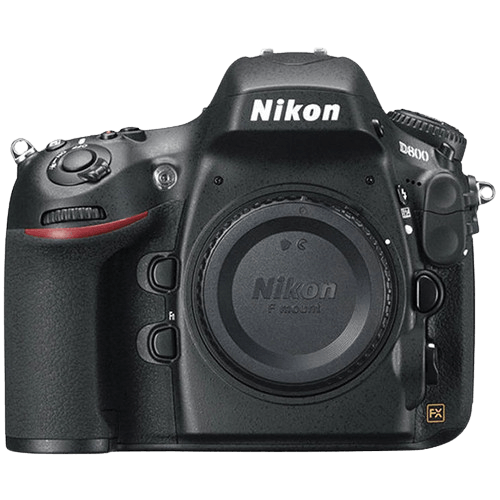Canon EOS 5D vs Nikon D800 Comparison
Canon EOS 5D

Nikon D800

The Nikon D800 triumphs over the Canon EOS 5D with a notable 29-point difference in scores, earning 69/100 compared to the Canon’s 40/100. Both cameras share the DSLR classification and were initially priced in the upper range, with the Canon at $2000 and the Nikon at $2999. They also have similar dimensions and weight, with the Canon being slightly lighter at 895g.
The Nikon D800’s higher score is due to its superior performance and more recent release year, 2012, as opposed to the Canon’s 2005 debut. However, the Canon EOS 5D has the advantage of a lower launch price and a more compact, lightweight design.
Considering these factors, the Nikon D800 delivers better overall performance, while the Canon EOS 5D offers affordability and portability for those prioritizing these aspects in their camera choice.
Canon EOS 5D vs Nikon D800 Overview and Optics
The Nikon D800 outperforms the Canon EOS 5D in optics, scoring 74/100 compared to the Canon’s 46/100. Both cameras share some common specifications, including a full frame CMOS sensor, no image stabilization, and a shooting speed difference of just one frame per second. However, the Nikon D800 has several advantages that contribute to its higher score.
The Nikon D800 boasts a significantly higher megapixel count at 36.3, compared to the Canon EOS 5D’s 12.7 megapixels. This difference allows the D800 to capture more detail and produce sharper images. Additionally, the Nikon D800 has a more advanced processor, the Expeed 3, compared to the Canon’s Digic II processor. This results in faster image processing and better overall performance.
Furthermore, the Nikon D800 has a higher DXOMARK score for its sensor, with a score of 95 compared to the Canon EOS 5D’s 71. This indicates that the D800’s sensor has better overall performance in terms of dynamic range, color depth, and low-light capabilities.
On the other hand, the Canon EOS 5D has the advantage of a wider range of compatible lenses due to its Canon EF lens mount. This provides users with more options for lens selection and versatility in different shooting situations.
Taking all these factors into consideration, the Nikon D800 emerges as the clear winner in terms of optics, delivering higher resolution images, better sensor performance, and a more advanced processor. While the Canon EOS 5D offers a wider lens compatibility, it falls short in the other key areas that contribute to overall image quality and performance.
Canon EOS 5D vs Nikon D800 Video Performance
When examining the video capabilities of the Canon EOS 5D and the Nikon D800, it becomes clear that the Canon EOS 5D lacks any video functionality. This absence of video recording features makes it impossible to compare the two cameras in this aspect. Therefore, the focus shifts to the Nikon D800’s video capabilities.
The Nikon D800 has a video score of 57 out of 100, which reflects its ability to record videos with a maximum resolution of Full HD (1920 x 1080). This camera is capable of recording videos at a maximum frame rate of 30 frames per second, ensuring smooth and clear footage. Additionally, the D800 possesses a built-in time-lapse functionality, a feature that allows users to create stunning time-lapse videos by capturing images at specific intervals and combining them into a single video file.
Taking into account the video capabilities of both cameras, it is evident that the Nikon D800 offers more in this category due to its ability to record videos, while the Canon EOS 5D does not provide any video functionality. This distinction should be considered by potential buyers when choosing between these two cameras, depending on their specific needs and preferences.
Canon EOS 5D vs Nikon D800 Features and Benefits
The Nikon D800 outperforms the Canon EOS 5D in features, scoring 57 points compared to the Canon’s 30 points. Both cameras share some common specifications, such as the lack of a touchscreen, flip screen, GPS, and Bluetooth. However, both cameras come equipped with WIFI capabilities.
The Nikon D800 surpasses the Canon EOS 5D in terms of screen size and resolution. The D800 boasts a 3.2-inch screen, while the 5D has a smaller 2.5-inch screen. Additionally, the D800’s screen resolution is significantly higher at 921,000 dots, compared to the 5D’s 230,000 dots. This difference results in a clearer and larger display for the Nikon D800, enhancing the user’s experience when reviewing images or navigating menus.
On the other hand, the Canon EOS 5D does not offer any significant advantages over the Nikon D800 in terms of features. Both cameras lack certain modern amenities, such as a touchscreen and GPS, which could be seen as a drawback for some users. However, these missing features do not make the Canon EOS 5D superior to the Nikon D800.
Considering the feature scores and specifications, the Nikon D800 is the clear winner in this comparison. Its larger, higher-resolution screen provides a better user experience, while the Canon EOS 5D fails to offer any notable advantages. Although both cameras lack some modern features, the Nikon D800 still stands out as the better option in this comparison.
Canon EOS 5D vs Nikon D800 Storage and Battery
The Nikon D800 outperforms the Canon EOS 5D in storage and battery with a score of 71/100, while the Canon EOS 5D scores 24/100. Both cameras share the absence of USB charging and accept Compact Flash memory cards.
The Nikon D800 excels with two memory card slots, accepting SD/SDHC/SDXC (UHS-I compatible) cards in addition to Compact Flash, offering greater storage flexibility. Moreover, the D800 boasts a battery life of 900 shots, powered by an EN-EL15 battery, significantly longer than the Canon EOS 5D’s 400 shots using a BP-511A battery.
Although the Canon EOS 5D falls short in comparison, it still provides adequate storage and battery life for casual photographers. It has one memory card slot and supports Compact Flash (Type I or II) cards.
Considering these factors, the Nikon D800 proves superior in storage and battery performance, making it a better choice for photographers requiring extended battery life and versatile storage options. The Canon EOS 5D, while not as strong in these aspects, remains a viable option for less demanding users.
Canon EOS 5D vs Nikon D800 – Our Verdict
Are you still undecided about which camera is right for you? Have a look at these popular comparisons that feature the Canon EOS 5D or the Nikon D800:

